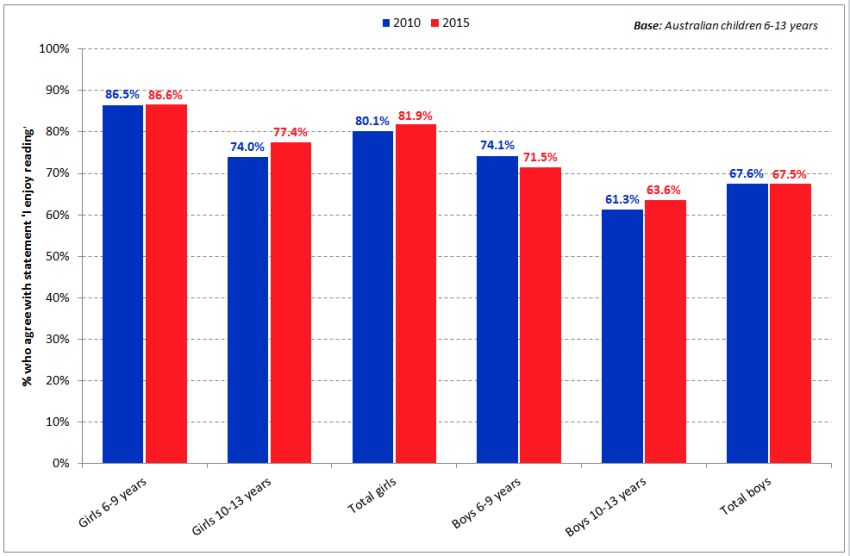May 10 2016
Finding No. 6803
Topic: Press Release
Country: Australia
Source: Roy Morgan Single Source (Australia), Jan-Dec 2010 (n=18,817) and Jan-Dec 2015 (n=14,666); Roy Morgan Young Australians Survey, Jan-Dec 2010 (n=3,372) and Jan-Dec 2015 (n=2,906)
In this digital day and age, where streaming TV, playing console games and social networking absorb so much of our leisure time, it’s only natural to question whether time spent on these activities might be impinging on our reading habits. Certainly, the latest findings from Roy Morgan Research confirm that the proportion of Aussies 14+ who read books is declining. But our data also shows cause for optimism, at least where children aged 6-13 years are concerned…
Between January 2010 and December 2015, the proportion of Aussie kids aged 6-13 who agree with the statement ‘I enjoy reading’ has inched up from 73.7% to 74.5% (an increase of 140,000 kids). Girls are traditionally more likely than boys to enjoy reading, and our figures bear this out: 81.9% of girls enjoy reading (up from 80.1% in 2010), compared with 67.5% of boys (virtually unchanged from 67.6% in 2010).
While younger (6-9 year-old) kids tend to enjoy reading more than their older (10-13 year-old) counterparts, enjoyment among the latter group – both boys and girls – is on the rise. Whereas 74.0% of 10-13 year-old girls and 61.3% of boys the same age reported that they enjoyed reading in 2010, both groups have since shown increases, as the chart below shows.
Australian girls and boys who ‘enjoy reading’: 2010 vs 2015

Source: Roy Morgan Young Australians Survey, Jan-Dec 2010 (n=3,372) and Jan-Dec 2015 (n=2,906)
Given their more widespread enjoyment of reading, it makes sense that a higher proportion of girls than boys spend their money on books: 27.8%, compared with 18.2% of boys. However, both boys and girls are more likely to save their money, or buy toys and snacks, than to purchase books. (On a more gender-specific note, purchasing console and computer games takes precedence over books for boys, as do clothes for girls.)
The decline of the bookworm
Among Australians 14+, a different picture emerges. The proportion of men and women reading books has decreased in recent years, most noticeably among women. In 2010, 64.7% of Australian women 14+ read a novel in any given three months, a figure which has since fallen to 60.9%. Similarly, fewer women are reading non-fiction books than they used to, slipping from 39.2% to 34.2% between 2010 and 2015.
This downward trend can be seen across all age groups, with the exception of women aged 65+, whose novel-reading incidence has crept up (albeit by less than a percent).
Novels, non-fiction, and our declining reading rate: 2010 vs 2015

Source: Roy Morgan Single Source (Australia), Jan-Dec 2010 (n=18,817) and Jan-Dec 2015 (n=14,666)
While the decline of reading incidence for both categories of book has been less pronounced among men, they remain less likely than women to read books (particularly novels).
As with women, this downturn is evident across all age groups, except the 65+ bracket, a greater proportion of whom are reading novels and non-fiction books than back in 2010.
Norman Morris, Industry Communications Director, Roy Morgan Research, says:
“With recent media reports of Australia’s school literacy levels lagging behind those of some other countries, it is encouraging to see a growth among children aged 6-13 reporting that they enjoy reading, and to learn that many are even willing to spend their own money on buying books.
“Past 14 years old, however, things aren’t looking so rosy. With the exception of older Australians, reading rates have declined considerably. The decrease among women is especially striking and raises several questions. Are their reading habits falling victim to other pursuits such as binge-watching streamed TV shows or surfing the web? Or are they simply more time poor than they once were?
“Not surprisingly, buying books and/or eBooks is also on the wane, having dropped more from 17.7% of the population making a purchase in any given four-week period to 15.8%. Although fewer men than women read, our data shows that men tend to spend more on average ($58) when purchasing books or eBooks than women ($52): something for retailers to bear in mind when planning marketing strategies.
“In this challenging market, book/ebook retailers need to stay abreast of how Australians’ changing leisure habits may be impacting on their reading, and work to ensure that books remain an appealing, relevant and rewarding part of everyone’s lives.
“This kind of information is also crucial for educators, giving them greater insights into their students’ attitudes to reading and what interests them, thereby allowing them to tailor their classes and coursework accordingly.”
Subscribe to our free mailing list and always be the first to receive the latest news and updates.
